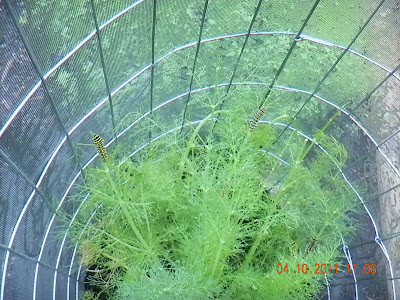
A few weeks ago when working in the garden I noticed some caterpillars on a dill plant. I'm not sure how I noticed them because they were teensy! This one was the big boy of the bunch -- others were so tiny they could barely be seen! I had made a butterfly cage a few years ago with some Master Gardener friends, but never had occasion to use it. By that I mean either I wasn't growing a host plant for butterflies, or the caterpillars were consumed by something before I ever noticed them.

But this time I was ready! I got the butterfly cage and took it down to the garden and put it over the dill plant. What you can't see here is that a little while later the cage was blown across the garden with a gust of wind, so I had to secure it in place with a couple of pieces of rebar.

Here's a close-up of the cage. If you go online you might see how to make one, but there are many different designs out there. We used fence wire (42") bent around into a cylinder and attached to itself, maybe 18" in diameter. Then it's covered with a black screencloth, sewn all the way down the side. The top is a circle of screencloth, attached with velcro so it can be put on and taken off.
 The caterpillars got really big chomping on dill! I was a little afraid they would devour the whole plant and run out of food, but that wasn't the case.
The caterpillars got really big chomping on dill! I was a little afraid they would devour the whole plant and run out of food, but that wasn't the case.
Here's a peek inside the cage! Maybe you can spot a couple of the caterpillars.

Pretty soon the caterpillars started forming their crysalises. By the way, this plural form is correct, CRI sa liss ez, but so is chrysalides, cri SAL un deeze. I never did see one forming, but each one attached itself to the inside of the cage with a silken thread, and then the caterpillar sheds its skin and forms the pupa. The chrysalises can be green or brown, depending on where they're attached, and the coloration is a camouflage device.

When the caterpillar is ready to pupate, it gets in a "J" position and spins the cord to attach itself. This isn't a very good picture, but it shows a green chrysalis with a caterpillar directly below in the "J" position.

Here's the same pair from the outside of the cage.

Then you just have to wait! Swallowtails take 9 - 11 days to emerge. We had two fly off a few days ago, and then nothing for two days. This morning when I went to the garden I could see three butterflies inside the cage!

I took the top off the cage to release the butterflies. Here's one sitting by the empty chrysalis.






7 comments:
How cool! I'm afraid my caterpillars were lunch for wasps.
Linda
Wow! I absolutely love this blog...and all of the love and care you provided for those beautify "butterflies". I adore the documentation of their "journey". You are a goddess of the garden! xo
going thru the sequence of photos ya got to see how to build this.. great idea AGAIN!!!
THANKS FOR THE INFO AND PICTURES!!
Awesome Cynthia! What a wonderful experience. I'm jealous of your garden!
Thanks for your comments! It was fun to watch and document! I need to get down there in a few minutes because there are still two chrysalises, and those guys will probably appear today! I wish my garden was closer to the house, but that's where the sun is!
UN
REAL
i love that you caught the flight out too...
me too P!
Last two left this morning -- I'm an empty nester! :-(
Post a Comment